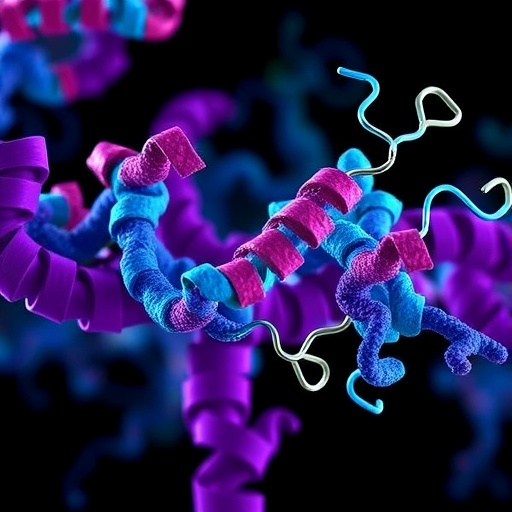In the relentless battle against cancer, a new frontier of molecular understanding emerges with the spotlight on the SP100 family of proteins. A comprehensive systematic review published in BMC Cancer unravels the complex roles of this protein family across a wide array of malignancies. As cancer cases worldwide surge, projected to reach 35 million new diagnoses by 2050, dissecting the biology behind tumor progression and suppression is more critical than ever. The SP100 family—comprising SP100, SP110, SP140, and SP140L—has captured scientific intrigue for its multifaceted functions in regulating gene expression, chromatin architecture, and immune signaling pathways, potentially offering new therapeutic avenues.
The SP100 family proteins are no mere bystanders in tumorigenesis; they participate actively in transcriptional regulation and chromatin modification, processes pivotal in maintaining cellular identity and preventing malignant transformation. SP100 itself has been hailed as a tumor suppressor in cancers such as breast carcinoma, where its elevated expression correlates with improved patient prognoses. Conversely, members like SP110 and SP140 have been linked to promoting progression in more aggressive cancers, including oral squamous cell carcinoma and gliomas. This dualistic nature—the ability to either inhibit or facilitate cancer progression depending on context—places the SP100 family at the nexus of cancer’s molecular complexity.
To piece together the disparate data scattered across two decades of research, Azami and colleagues undertook a rigorous systematic review guided by PRISMA protocols. By meticulously combing through multiple scientific databases and employing tools like RAYYAN for data refinement, they extracted critical insights from 29 studies encompassing 25 distinct cancer types. Their analysis delves deeply into the genetic and epigenetic modifications of SP100 family members and correlates these alterations with clinical outcomes. The breadth and precision of this approach provide a panoramic view of how SP100 proteins contribute to oncogenesis and tumor suppression in diverse biological contexts.
The findings reveal a nuanced landscape: SP100 expression levels exhibit tissue- and tumor-specific prognostic value. Elevated SP100 in breast and lung cancers often signifies a better survival outlook, in stark contrast to gliomas and pancreatic adenocarcinoma (PAAD), where high SP100 heralds poorer outcomes. Intriguingly, in laryngeal squamous cell carcinoma (LSCC), diminished SP100 expression correlates with tumorigenic processes. This context dependency underscores the complexity of regulatory networks involving SP100 and hints at the possibility that its functions might be modulated by surrounding cellular environments and interacting protein partners.
SP110’s role complicates the narrative further. While overexpression portends unfavorable prognosis across multiple malignancies such as oral, lung, and renal cancers, it paradoxically confers a protective effect in diffuse large B-cell lymphoma (DLBCL). This dichotomy suggests that SP110’s oncogenic or tumor-suppressive functions might be immune-context dependent, perhaps influencing or influenced by tumor microenvironmental factors. Such duality challenges the straightforward categorization of cancer biomarkers and calls for a refined understanding of SP110’s molecular effectors and pathways.
Among all family members, SP140 emerges as the most extensively investigated and exhibits the most divergent associations with patient outcomes. High SP140 expression correlates with worsened prognosis in clear cell renal cell carcinoma (ccRCC), glioma, and gynecologic cancers, yet paradoxically improves survival in acute myeloid leukemia (AML), osteosarcoma, and melanoma. This yin-yang pattern again highlights how SP140’s molecular context critically dictates its biological impact. Genetic alterations such as mutations, copy number variations, and DNA methylation across SP100 family genes significantly contribute to prognosis in both hematologic and solid tumors.
SP140L, the least studied member, has piqued interest due to its association with poor prognosis in pancreatic adenocarcinoma, an aggressive cancer notorious for its dismal survival rates. Given the limited data on SP140L, further exploration of its mechanistic roles in pancreatic oncogenesis and metastasis is highly warranted. Understanding how SP140L interplays with canonical oncogenic drivers could open new therapeutic frontiers for a cancer type desperately in need of better targeted treatments.
This review places the SP100 family firmly on the oncology landscape not only as biomarkers that reflect tumor behavior but also as promising targets for therapeutic intervention. Highlighting SP140 as a prime candidate biomarker, the authors propose strategies centered on inhibiting SP100 or SP140 proteins to leverage their tumor-suppressive functions or counteract their oncogenic roles. Developing targeted inhibitors could revolutionize the therapeutic arsenal, particularly in cancers where current treatments fail to sufficiently improve patient outcomes.
Nevertheless, challenges persist. The authors note geographic biases in the literature, with many studies concentrated in specific regions, potentially limiting the generalizability of findings. Additionally, sparse data around SP140L and incomplete mechanistic characterizations of SP110 emphasize the need for expansive, multi-center studies. Standardization of analytical methods and integration of mechanistic research focusing on immune microenvironment interactions will be pivotal to translating these proteins from molecular signatures into viable clinical tools.
With the paradigm of precision oncology evolving rapidly, incorporating SP100 family proteins into clinical trials represents a promising leap forward. Targeted therapies that modulate these proteins could synergize with existing immunotherapies, enhancing efficacy and overcoming resistance mechanisms. The comprehensive insights provided by this systematic review pave the way for designing trials that tailor treatments based on the molecular fingerprint of each tumor, advancing personalized medicine.
The multifaceted roles of SP100 family proteins echo the broader complexity of cancer biology, where molecular players can switch identities based on cell type, tumor microenvironment, and genetic background. Embracing this complexity is crucial to overcoming the limitations of one-size-fits-all treatments. As we deepen our understanding of the intricate dance between oncogenes and tumor suppressors, the SP100 family rises as a critical set of conductors orchestrating cancer progression or suppression.
In summary, the systematic review by Azami and colleagues consolidates existing knowledge and unearths new avenues of research within the SP100 protein family. Their work not only underscores the prognostic and therapeutic potential of these proteins but also highlights the essential need for nuanced, context-aware interpretations of molecular data. As the oncology community poisedly turns to precision medicine, SP100 family proteins offer fertile ground for the next generation of cancer diagnostics and treatment innovations.
The path forward beckons with the promise of deeper mechanistic studies, larger diverse patient cohorts, and innovative clinical trials. By embracing the dual roles of SP100 family proteins in cancer, researchers and clinicians alike can move closer to tailored interventions that transform patient outcomes. Thus, the SP100 family stands not only as a beacon of molecular insight but also as a potential linchpin in the future landscape of cancer therapeutics.
Subject of Research: Expressions and roles of SP100 family proteins (SP100, SP110, SP140, SP140L) in various human cancers, focusing on their genetic/epigenetic alterations, prognostic value, and therapeutic potential.
Article Title: Clinical and mechanistic insights into the expression of SP100 family proteins in various cancers: a systematic review
Article References:
Azami, M., Sadeghi, F., Mohammadi, N. et al. Clinical and mechanistic insights into the expression of SP100 family proteins in various cancers: a systematic review. BMC Cancer 25, 1700 (2025). https://doi.org/10.1186/s12885-025-15159-9
Image Credits: Scienmag.com
DOI: 10.1186/s12885-025-15159-9 (Published 04 November 2025)
Tags: cancer diagnosis projections 2050chromatin modification in cancerimmune signaling pathways in malignanciesmolecular understanding of cancer biologyroles of SP100 proteins in tumorigenesisSP100 family and patient prognosesSP100 protein family in cancerSP100 tumor suppressor functionSP110 and SP140 in aggressive cancerssystemic review of SP100 proteins in cancer.therapeutic avenues targeting SP100 proteinstranscriptional regulation and cancer





